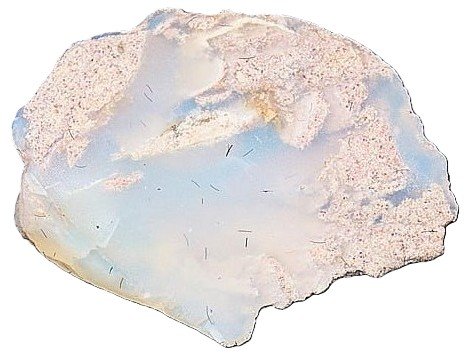
The name “opal” originates from the Latin word opalus, which is derived from the Greek opallios, meaning “to see a change in colour.” This, in turn, is thought to trace back to the ancient Sanskrit word upala, meaning “precious stone.” Historically, opal has been known by various names, such as “Queen of Gems” due to its dazzling play-of-colour. Precious opals displaying iridescence are distinct from common opals, which lack this characteristic.
Composition and Physical Characteristics
Opal is a hydrated amorphous form of silica (SiO₂•nH₂O), with a water content that can range between 3% and 21%, though typically around 6% to 10%. Unlike crystalline gemstones, opal is non-crystalline, giving it a unique internal structure that diffracts light, creating its mesmerising play-of-colour.
Varieties of Opal:
- Precious Opal: Displays iridescence due to internal silica spheres.
- Common Opal (Potch): Lacks play-of-colour but occurs in a variety of hues.
- Black Opal: The rarest and most valuable, with a dark body tone enhancing colour vibrancy.
- White Opal: A milky or translucent variety with a softer play-of-colour.
- Fire Opal: A vivid orange, red, or yellow variety, often translucent to transparent.
- Boulder Opal: Found within ironstone, retaining a natural host rock backing.
- Crystal Opal: Highly transparent or translucent, displaying bright colour flashes.
Geographical Locations
Opal is found across the globe, with notable deposits in:
- Australia: The premier source, accounting for approximately 95% of the world’s opal. Major locations include Lightning Ridge (black opal), Coober Pedy (white opal), and Andamooka.
- Ethiopia: Producing high-quality opals, particularly the Welo opals known for their transparency and vibrancy.
- Mexico: Famous for fire opals, particularly those found in Querétaro.
- Brazil: Produces both common and precious opals.
- USA: Notable opal sources include Nevada and Idaho.
- Honduras: Produces a distinctive black opal matrix variety.
Archaeological and Significant Finds
Opal has been valued since antiquity. The Romans considered it the most precious of all gemstones. Opals have been discovered in archaeological sites dating back over 6,000 years in Kenya. Australia’s opal fields have yielded remarkable finds, including opalised fossils, such as a complete opalised dinosaur discovered at Lightning Ridge.
Historical and Current Usage
In ancient Rome, opal was associated with hope and love, often set in fine jewellery.
The Aztecs prized fire opals, using them in ceremonial artefacts. Today, opal remains a popular gemstone for rings, necklaces, and ornamental carvings. High-quality opals are particularly sought after for their investment potential.
Interesting Facts
- Opal is one of the only gemstones that can display every colour of the spectrum.
- Some opals are “hydrophane,” meaning they can absorb water and temporarily change appearance.
- The largest opal ever discovered is the “Olympic Australis,” weighing over 17,000 carats.
Folklore, Superstition, Legends, and Tales
Opal has an intriguing history of superstition. In medieval Europe, it was believed to bring both good fortune and misfortune. During the 19th century, Sir Walter Scott’s novel Anne of Geierstein falsely associated opal with bad luck, leading to a temporary decline in its popularity. However, in Middle Eastern folklore, opal was believed to have fallen from the heavens during thunderstorms, trapping lightning within its depths.
Mystical Healing Properties
Opal is often associated with emotional healing, creativity, and inspiration. It is thought to:
- Enhance self-expression and imagination.
- Aid in emotional balance and release negative emotions.
- Amplify personal energies and assist in spiritual awakening.
Astrology and Zodiac Links
Opal is traditionally linked to Libra but is also beneficial for Scorpio and Pisces. Astrologically, it is believed to promote harmony, love, and passion while protecting the wearer from negative influences.
Chakra System
Opal is associated with multiple chakras depending on its colour variety:
- White Opal: Crown Chakra – Enhancing spiritual connection and clarity.
- Black Opal: Root Chakra – Providing grounding and stability.
- Fire Opal: Sacral Chakra – Boosting creativity and passion.
- Blue Opal: Throat Chakra – Supporting clear communication.
Birthstone and Wedding Anniversary Use
Opal is the birthstone for October, symbolising hope, purity and creativity. It is also traditionally gifted for the 14th wedding anniversary, representing love and emotional depth.
